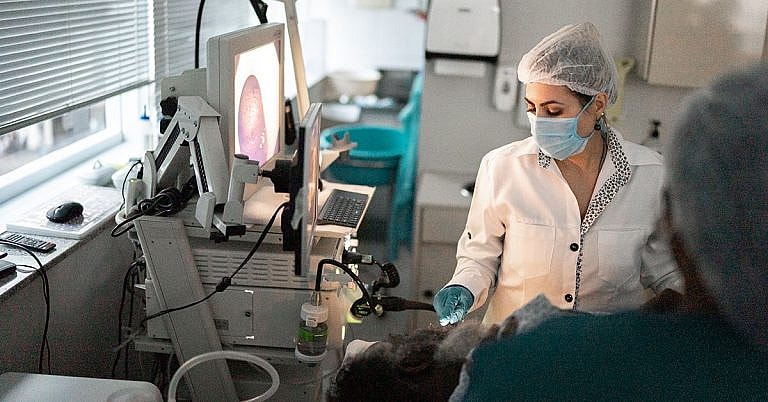What is Partial Removal of Lung: Overview, Benefits, and Expected Results
Original Excerpt:
```html
Headline: The Power of Positive Thinking
Body:
Positive thinking is a powerful tool that can help you achieve your goals and live a happier life. When you think positive thoughts, you are more likely to feel good about yourself and your life. You are also more likely to take action and make things happen.
```
Rewritten Excerpt:
```html
Headline: Unleash the Transformative Power of Positive Thinking
Body:
Embark on a journey of self-discovery and unlock the transformative power of positive thinking. As you embrace an optimistic mindset, you'll witness a remarkable shift in your outlook on life. Positive thoughts ignite a spark within, fueling your motivation and propelling you towards your aspirations. Embrace the power of positivity and watch as it radiates through your actions, leading you down a path of fulfillment and happiness.
```
Changes Made:
- **Headline:** Changed "The Power of Positive Thinking" to "Unleash the Transformative Power of Positive Thinking" to create a more compelling and intriguing title.
- **Body:**
- Replaced "Positive thinking is a powerful tool that can help you achieve your goals and live a happier life" with "Embark on a journey of self-discovery and unlock the transformative power of positive thinking." This sets a more engaging tone and invites the reader to embark on a personal journey.
- Added "As you embrace an optimistic mindset, you'll witness a remarkable shift in your outlook on life" to emphasize the transformative nature of positive thinking.
- Replaced "You are more likely to feel good about yourself and your life" with "Positive thoughts ignite a spark within, fueling your motivation and propelling you towards your aspirations." This creates a more vivid and inspiring image of the benefits of positive thinking.
- Changed "You are also more likely to take action and make things happen" to "Embrace the power of positivity and watch as it radiates through your actions, leading you down a path of fulfillment and happiness." This highlights the tangible impact of positive thinking on one's actions and overall well-being
Definition and Overview
The partial removal of the lung is a surgical procedure performed for the treatment of lung conditions including lung cancer.
There are many different types of partial lung removal surgery depending on which part of the lung is removed. These include:
Lobectomy – Removes an entire lobe that contains a malignant tumour as part of cancer treatment. The lungs have a total of five lobes, 3 of which make up the right lung and two the left lung. Of all the different types of lung removal surgery, this is the most preferred.
Pneumonectomy – Removes an entire lung if there is a malignant tumour or lesion near the centre of the chest.
Segmentectomy – Also known as a wedge resection, this procedure removes only a portion of a lobe. It is an alternative option if a lobectomy cannot be performed due to the patient’s overall health condition.
Surgeons decide on the most appropriate procedure depending on the size and location of the diseased part of the lung and how well the lungs are functioning. If a person’s lungs are in relatively good health, doctors often recommend a more aggressive procedure.
Who Should Undergo and Expected Results
Partial lung removal surgery is beneficial for patients who suffer from:
Lung cancer
Benign tumours/lesions in the lung
Bronchiectasis
Haemothorax (blood clots in the lungs)
Solitary pulmonary nodules
Empyema (infection in the chest cavity)
Tuberculosis complications
Pernicious anaemia
Cystic fibrosis
Of all these diseases, lung cancer is the most common reason why lung removal procedures are performed. Lung cancer surgery is, in fact, the primary treatment for early stage non-small cell lung cancer (NSCLC). The procedure is known to provide patients with the best chance of cure for their condition.
Prior to the procedure, patients undergo several pulmonary function tests to determine how much healthy lung tissue will remain after surgery and if this is sufficient to retain normal lung function for the patient. The doctor may also perform a lung biopsy, in which a small sample of the lung tumour and parts of lymph nodes near the lungs are taken to check for malignant cells and possible cancer spread.
Despite its important role in the treatment of early stage lung cancers, the procedure is not particularly effective for advanced stage lung cancers, especially if tumours have already spread to the lymph nodes between the lungs.
How is the Procedure Performed?
There are two ways through which partial removal of lung can be performed. The first is the more traditional method called thoracotomy, which involves making a large chest incision and spreading out the ribs to gain access to the lungs. In some cases, surgeons may also need to remove a rib. Open lung surgery usually takes between two and six hours.
The other method is called minimally invasive video-assisted thoracic surgery (VATS), which is the preferred procedure for early stage lung cancers. Instead of making a large chest incision, the surgeon makes several tiny cuts in the side of the chest where a thin tube with a video camera attached to its end and other specialised surgical instruments are inserted. The video camera sends live images of the inside of the chest cavity to a computer monitor, providing the surgeon with visual guidance. One of the cuts is then enlarged in order to take out the removed portion of the lung. After surgery, a tube is attached to the chest to drain excess fluid and air from the surgical site. Patients who undergo this procedure have to stay in the hospital for four to five days.
Recovery from a partial removal of lung may take several weeks to a few months, especially if surgery involved a large chest incision. Patients who undergo VATS as well as those whose lungs are in good condition recover faster.
Possible Risks and Complications
Patients may experience some side effects following a partial lung removal, such as shortness of breath after certain levels of activity. These side effects are usually more bothersome for patients who have another lung disease or are long-time smokers.
Lung cancer surgery patients also face some potential complications, such as:
Failure of the lung to expand
Injury to nearby organs and blood vessels including the diaphragm, trachea, and oesophagus
Prolonged air leakage
Fluid buildup in the chest cavity
Disturbances in heart rhythm
They are also at risk of complications commonly associated with any type of surgery, including:
Infection
Bleeding
Blood clots in the legs or lungs
Adverse reactions to anaesthesia
To minimise the above risks, patients must follow their doctor’s instructions before the procedure. They should avoid taking drugs that make it hard for blood to clot and stop smoking several weeks before the procedure.
There are also some precautions that should be taken after surgery. Patients are given medications and compression stockings to prevent blood clots and are advised to do deep breathing exercises to prevent lung infection and pneumonia.
References:
“Does Division of the Pulmonary Ligaments Affect the Outcomes after Thoracoscopic Lobectomy: A Retrospective Study of 72 Cases” West Indian Medical Journal. https://www.mona.uwi.edu/fms/wimj/category/keywords/vats-upper-lobectomy
Sheikh SI, McCoy K, Ryan-Wenger NA, Patel A, Kirkby S. “Lobectomy in patients with cystic fibrosis.” Can Respir J. 2014 Jul-Aug; 21(4): e63-e66. https://www.ncbi.nlm.nih.gov/pmc/articles/PMC4173894/
Jie Xiang, Su Yang, Wei Guo, Runsen Jin, Yajie Zhang, Xingshi Chen, Han Wu, Hailei Du, Dingpei Han, Kai Chen, Hecheng Li. “Robotic-assisted thoracoscopic surgery: left upper lobectomy.” AME Medical Journal. http://amj.amegroups.com/article/view/3675/4409
/trp_language]
[trp_language language=”ar”][wp_show_posts id=””][/trp_language]
[trp_language language=”fr_FR”][wp_show_posts id=””][/trp_language]
**What is Partial Removal of Lung: Overview, Benefits, and Expected Results**
**Question:** What is partial removal of lung?
**Answer:** Partial removal of lung, also known as lung resection, is a surgical procedure in which a portion of the lung is removed due to various medical conditions. This procedure is commonly employed to treat lung cancer, but it can also be indicated for other lung-related conditions such as benign tumors, lung infections, or extensive lung damage.
**Question:** When is partial removal of lung necessary?
**Answer:** Partial removal of lung may be recommended in the following situations:
* **Lung Cancer:** This is the primary indication for partial lung resection. It involves removing cancerous tissue while preserving healthy lung tissue.
* **Infections:** Chronic lung infections such as tuberculosis or fungal infections may require localized resection of the affected lung tissue.
* **Lung Abnormalities:** Benign lung tumors, cysts, or areas of damaged or collapsed lung may warrant partial lung removal.
* **Trauma:** Extensive lung injuries due to trauma may require surgical resection of the affected tissue to promote healing and prevent complications.
**Question:** What are the benefits of partial removal of lung?
**Answer:** The potential benefits of partial lung resection include:
* **Cancer Treatment:** Removing cancerous lung tissue can improve survival rates and prevent further spread of cancer.
* **Symptom Relief:** Resection of infected or damaged lung tissue can alleviate symptoms such as shortness of breath, coughing, and chest pain.
* **Improved Lung Function:** Removal of diseased or damaged lung tissue can allow the remaining healthy lung tissue to function more efficiently.
* **Minimal Invasive Techniques:** In many cases, partial lung resection can be performed minimally invasively through video-assisted thoracic surgery (VATS), resulting in smaller incisions and shorter recovery time.
**Question:** What are the expected results after partial removal of lung?
**Answer:** The expected results of partial lung resection depend on the underlying condition, extent of lung removed, and individual patient factors. Generally, patients can expect:
* **Successful Cancer Treatment:** Partial lung removal for early-stage lung cancer can often lead to long-term survival outcomes.
* **Symptom Improvement:** Patients with lung infections or abnormalities typically experience significant improvement in their symptoms after resection.
* **Preservation of Lung Function:** After initial recovery, most patients regain normal or near-normal lung function, allowing them to resume normal activities.
* **Recovery Period:** Recovery time varies based on the extent of surgery, but most patients can expect to stay in the hospital for a few days followed by a gradual return to normal activities over several weeks.
**Question:** What are the potential risks and complications associated with partial removal of lung?
**Answer:** Potential risks and complications of partial lung resection include:
* **Infection:** There is a risk of postoperative infection in the remaining lung tissue.
* **Bleeding:** Excessive bleeding during or after surgery is a potential complication.
* **Air Leak:** A leak in the lung tissue can occur, leading to pneumothorax (collapsed lung).
* **Respiratory Problems:** Reduced lung capacity may initially cause shortness of breath and other respiratory issues.
* **Pain:** Patients may experience pain or discomfort after the surgery, which can be managed with medication.
* **Long-Term Effects:** In rare cases, long-term effects such as persistent respiratory issues or reduced exercise tolerance may occur.
It is important to discuss these risks with your doctor before undergoing partial lung resection to understand the benefits, risks, and expected outcomes specific to your situation.








# Partial Lung Removal: A Comprehensive Overview, Benefits, and Expected Surgical Outcomes
# Partial Lung Removal: Indications, Surgical Techniques, Potential Advantages, and Long-Term Outcomes